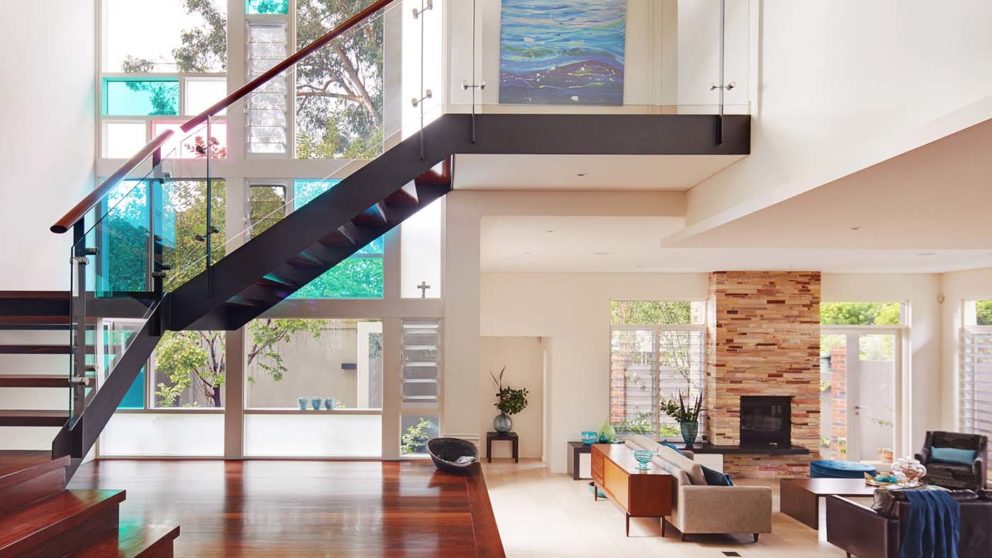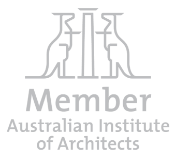
In this interview Suzie Hunt talks about style, residential architecture, interiors and the process of designing a home.
Q: What do you love about being an architect?
Architecture is about people. I love people, I love talking with people and listening to their vision. I love understanding where they’re coming from. I feel very lucky to be an architect and to be able to translate my client’s personal vision into their new home.
Q: How would you define your style?
That’s a question I get asked a lot. I usually turn it around and say, tell me about your style. That’s what I am really interested in. What do you like? What do you hate? It’s not really about my style. My role is to understand what you want, your personal vision and your needs. I want to design something that’s full of your personality – not mine. So when I’m designing your home, I want to create something you and your family will love to live in. That’s why no two houses I design are ever the same.
Q: What do you value?
I truly believe that great architecture nourishes peoples lives not only physically but spiritually and emotionally. This is really important to me. I want the homes I design to express harmony, warmth and a calm simplicity.
I love honest, robust and earthy materials, beautiful detailing and creating a feeling of sensuality and elegance. I want your home to seamlessly fit into its landscape and suit the climate.
My designs often blur the inside and outside space. I love the feeling that nature can be part of the interiors in a gentle way. The landscape and home design might come together in a couple of different ways. For example, it might be separate courtyards that have a particular view, or windows that frame a special tree, or stairwells that have a patch work of different coloured glass to capture the northern light.
I really value my clients and our relationship. To me it’s really important that they enjoy the journey, it should be fun not stressful, that you feel heard and part of it all and its my job to nurture you and make sure you are happy.
Q: What sort of projects do you work on?
Right now I’m pretty busy with residential projects. I’m doing a lot of contemporary new-build projects, either alterations and additions to existing houses, or heritage listed properties in Perth and the South-West.
Q: Do you work with a team?
Yes, I employ a small team of architectural and interior draftspeople however I am very hands on along with my colleague Catherine Lee a French architect. Cat has worked with me for 11 years and our synergy is pivotal to our success. I’ve also got a lot of strong relationships with engineers and builders who I’ve worked with on many projects. Building a home for a family is a team effort. I’m still your main point of contact for the architecture and interior design.
I only accept a limited number of projects at any one time. It means we can give your project the attention it deserves.
The Starting Point
Q: Should I wait until I have bought my land before I come to see you?
There’s real advantages in speaking to me before you buy and I’ll tell you why. I can advise you on the opportunities and constraints of your purchase. This will save you money and possibly some disappointment. It’s best to buy something that is going to suit the project you have in mind.
Q: I have some ideas about what I want in my new home or renovation, what else helps you understand what I’m looking for?
Your initial thoughts are a really valuable starting point. My job is to give you confidence.
You might say to me, “This is what we think we want to do.” I get a lot of joy from helping you feel confident about your own ideas. I love taking that idea and building on it with you.
I’m really interested in your life, and that to me is the important part of the briefing process. I really like finding out about you and your family and what you need. I want to listen. The essence of good home design is finding out how you live day to day. I prepare for the design by discovering the pattern of your daily life.
The project brief comes from this careful discussion about the areas you spend most time in. We discuss what you need from those areas and how you would like your living spaces connected. For example, I might ask you questions like: Where do you want the kitchen to be? Do you want to have the access outside? Do you want to go from your kitchen to your laundry? From this discussion I can put together a zone diagram. That drawing lets me know how you would like to use the spaces in your new home.
The Design
Q: Now that you have a brief, how do you develop the design?
I like to be flexible in my design approach. I work with my clients to develop as many sketch design options as we need until we are all comfortable with the preferred option.
From there, with the help of engineers, we take the sketch design to the next level. At this point we also start talking to local authorities about planning approval and start to consider the interior design.
Q: Once I build my new home, I don’t want to move for some time. Does that influence your design?
Yes, for sure. What you are really talking about here is design flexibility. To make your house flexible, we’ll talk about your lifestyle and what matters to you. I want to know your story, because I want to design a home that reflects your lifestyle, and that offers you flexibility and adaptability as your family’s circumstances change. Adaptability can be a subtle and elegant thing, it doesn’t have to be obvious. For example, I might be designing for trans-generational living, looking at your changing needs with young kids through to teenagers, and empty-nesters looking forward to their retirement and grandchildren. You might be looking for self-control of your aging journey to retain your independence. So we might look at catering for self-care and in-house nursing care, and plan things so they’re accessible.
Q: How involved would I be?
You’ll be as involved as much as you want to be. I encourage all my clients to be an integral part of the team during the design, documentation and construction journey. For me, communication is key and I’ll encourage and seek your input at all times. This is, after all, your journey to a new home.
There are lots of meetings, site meetings and consultations with the engineering team. You can attend all of the meetings or just some, whatever you choose. We keep notes of all our meetings, and you’ll get a copy of these even if you’re not there. I want you to understand the process and feel engaged and heard.
Interior Design
Q: What is your approach to interior design?
I believe interior design is part of the overall design of your home. Architecture and interior design are totally integrated in the way I work – it saves you time and money, and gives you a more resolved home.
To me a house becomes a home when the interior design reflects the family that lives in it. Not the designer. So I’ll help you with every aspect of your interiors including furniture design, soft furnishings and lighting selections. Sometimes I like to leave walls and spaces free for you to fill with your favourite furniture. Perhaps you’ll go on an overseas holiday and find something special, or you might receive a special piece of furniture from a loved relative. There is no right or wrong piece if it reflects your personality.
I try to make the daunting but important task of selecting materials easier for you. We often prepare interior design options, sample boards with materials and present them in the comfort of our office. This saves you time and running around. We also can visit supplier warehouses when it’s helpful.
Sustainability
Q: Tell me more about environmental sustainability and passive design.
Good architecture is sustainable. The three elements of sustainable design that guide me throughout the project are passive design considerations, choice of materials and integration of renewable energies.
Passive design considerations influence the initial orientation of your home to capture sea breezes, the sun in winter and shade in summer and is closely related to the selection and design of the landscaping. I choose materials for their enduring quality and we like to seamlessly integrate renewable energies including water collection, waste treatment and solar power. Sustainable architecture will save money and create a more comfortable place to live.
Landscaping
I like a landscape designer to be part of the design team because the landscape design is an integral part of the home design. This is very important to me because I love my designs to have strong connection with the landscaping where the interiors and exteriors flow. We are trying to create outdoor rooms that give a relaxing resort quality to peoples’ everyday lives.
Contract Documentation
Q: Do you do working drawings, or shall I go to a draftsman?
Once the design is settled we move on to documentation. I have a commitment to excellent documentation in my practice. I find it saves a lot of hassle during the construction phase to be clear right from the start. I actually have an outstanding documenters. Our documents are always very tight. That’s how I need them to be. They cover the interior design elements as well. All our schedules – everything forms a package. Good documentation saves you money.
Procurement & Contract Administration
Q: Can you explain how the procurement and process is managed?
Once the documentation is complete I’ll help you choose the builder in whichever contract form is going to be the best fit. This is your choice and I can help you understand the strengths of different approaches. I’ll be happy to give my recommendations and respect the choice that’s going to work for you.
Q: What happens during construction of my house?
We have a contract with you, and our job is to mediate between you and the builder. During the construction phase we are not contractually bound to the builder and have no conflict of interest when administering the contract.Our job is to protect you and ensure you enjoy the journey. We deal with all the builders’ queries and assess and approve progress claims to ensure you aren’t paying for work that has not been completed. We have regular site meetings that you are invited to. It is our responsibility to see that the integrity of the design is maintained for you until the end of the project.
The Budget
Q: How do you ensure the project keeps to my budget?
We see budgets as very important. We discuss your budget at our initial meeting. Consistently through the project we review the budget against the brief and seek your approval for any changes.
This is where working with a trusted team – engineers, quantity surveyors, builders – really comes into play. I know that they are working hard to keep within the budget as well, because it’s a core value we share.Our consultation process with you means that you know what’s going on. If a decision is made to change something you will know the implications. It’s your choice and you’ll feel informed.Making sure everyone is responsible about the project budget is vital.
Completion
Q: How do you feel at the end of a project?
At the end of a project I feel so excited that my clients will get to the live in this home we’ve created together. The journey from the initial meeting to completion may take two to five years depending on the size or complexity. I develop strong relationships with my clients. I’ve been invited to birthdays. I know my clients’ children, and I’ve been invited to engagement parties.I have to say, there’s a bit of a grieving at the end of a project. I miss them. And sometime they ring me and say “Oh, I’ve really missed you. Do you want to come up and have a coffee?” That’s the part I enjoy most – seeing people experience and enjoy the homes I’ve designed for them.


